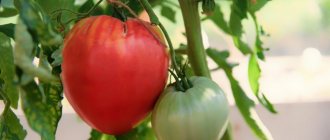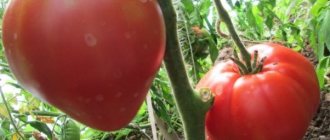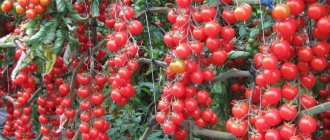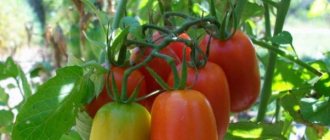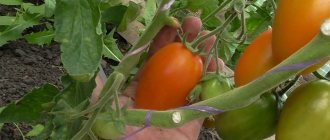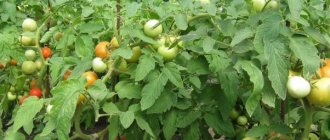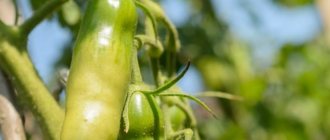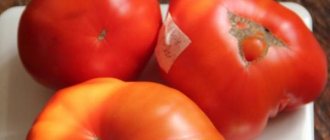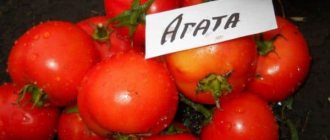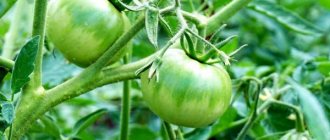Mid-season, indeterminate tomato hybrid for growing in greenhouses, open ground and under temporary shelters. The period from germination to the beginning of ripening is 111-115 days.
The plants are powerful, medium-sized, about 1.5 meters high, with short internodes and large dark green leaves. It requires tying the bush to a support and pinching. The best results were obtained when formed into 2 stems.
Basic qualities of fruits
The fruits are large, flat-round, bright pink in color at maturity, weighing up to 400 grams, not prone to cracking. The pulp of the fruit is tender, juicy, tasty, with a “melting” consistency. These tomatoes are good for fresh consumption, making juices and sauces. Recommended for children's and dietary nutrition.
Tomato yield Rosemary
If you follow agricultural technology, you can get up to 4 kg of fruit from 1 bush of this variety. That is, if you planted the seeds on time, grew good strong seedlings and, after planting them in a permanent place, cared for the tomato according to all the rules, then you are guaranteed to get a good harvest. Of course, the weather makes minor adjustments, but with proper care you will always get 4 kg of tomatoes from 1 plant.
The manufacturer claims yield: 8-11 kg/sq.m. (subject to watering and fertilizing, compliance with agricultural technology).
Description and characteristics of the variety
Rosamarine pound is an indeterminate tall variety. Included in the State Register since 2008. Initially intended for cultivation under film, but in warm regions planting in open beds is possible.
Features of the bushes:
- shoot height 1.7-2 m;
- powerful stems;
- number of tomatoes per bunch 5-7;
- 7-8 tomato bunches.
The ripening time for Rosemary pound from Gavrish is average - 115-125 days from germination. Description of tomatoes:
- average weight 350-450 g;
- color bright red;
- the pulp is fleshy, oily, moderately juicy;
- oblate spheroid shape;
- the skin is strong;
- seed chambers within 4-6.
The taste is a harmonious combination of sourness and sweetness. The pulp resembles watermelon.
general description
Rosamarin pound is a tomato variety bred by Russian breeders. In 2008 it was included in the Russian register. It is produced by various manufacturers, in particular Gavrish.
Note! Rosamary pound is often confused with Rosemary F1. These are different tomato crops with different characteristics.
Since Rosamarin pound is a cultivar, the seeds from the fruit can be used for planting. They are collected from berries ripened on the bush, washed and dried. Store planting material in fabric bags.
Distinctive features
Rosamarin pound differs from other varieties in the unusual shape of its fruit. Its berries are deep pink inside and out. They are round, flattened on both sides, with pronounced ribbing at the base, which extends onto the body of the tomatoes, literally dividing them into slices.
A photo of the fruit is presented below.
The pulp of such fruits is tender and literally melts in your mouth. It has a sweet taste with barely noticeable sourness.
The berries are large. Each of them weighs almost half a kilogram. It is for its large fruit that the tomato received the name Rosamarin pound.
Another distinctive feature of the variety is the increased content of vitamin A in the fruit pulp. Therefore, it is especially useful for children and people suffering from cardiovascular diseases.
The tomato is immune to the most common nightshade diseases. He is not afraid of late blight either. This greatly facilitates cultivation and reduces the need to use chemicals.
Main characteristics
Rosamarin pound has high immunity and excellent taste of the fruit. The description of this variety will please even experienced gardeners.
Characteristics of Rosamarin pound:
| Parameter | Indicators |
| Bush type | Indeterminate variety (grows throughout the entire growing season). The height of the main stem reaches 1.5 m. The bushes are covered with a moderate amount of foliage. The leaf blade is long and narrow, wrinkled, simple in shape and dark green in color. The stems are thick and powerful. The inflorescences are simple, the first is formed in the axil of the tenth leaf, and the rest every 2-3 leaves. The rhizome is powerful, it grows greatly in breadth. |
| Growing method | In the southern regions it is recommended for planting in film shelters. In the central part of the country - in unheated greenhouses, in the northern regions - in heated rooms. |
| Productivity | High. From 1 sq. m, 10–15 kg of fruits are collected. |
| Fruit | Large ones. One berry weighs on average 500 g. Some specimens reach a weight of 1000 g. The color of the fruit is bright pink inside and out. The presence of yellowish and greenish spots may be present. The shape of the fruit is round, flattened on both sides. There is pronounced ribbing at the base, which extends to the rest of the body of the fruit. The pulp of the berries is tender and juicy, melting in your mouth. The taste is sweet, with slightly pronounced sourness. Inside each fruit there are eight chambers with small seeds. |
| Transportability | Low. Berries are easily damaged during transportation. They are stored for no more than two weeks. |
| Ripening time | Mid-season variety. The fruits ripen 110–115 days after sowing the seeds. Fruiting continues all summer. |
| Disease resistance | Is immune to most tomato diseases. Not afraid of late blight, fusarium, tobacco mosaic, cladosporiosis. |
Agricultural technology Rosamarina pound
Rosamarin pound is grown only in protected soil. It is under such conditions that the highest yields are recorded.
You can plant seedlings in a permanent place in early March. In protected soil, the soil will already be quite warm during this period.
Transplanting
Before planting tomatoes, prepare the soil. In autumn, the beds are dug up and cleared of plant debris. For 1 sq. m add 4 kg of humus. If the acidity of the soil is increased, it is reduced with dry lime.
In the spring, the beds are leveled with a rake, cleared of weeds, and watered with copper sulfate.
The holes are dug in rows in a checkerboard pattern. For 1 sq. m no more than three plants are planted. With a denser planting, fewer fruits will be produced on the bushes.
1 tbsp is poured into the bottom of each hole. l ash. Plants are placed in them, forming roots towards the center. The holes are covered with earth, each one is watered with a liter of water.
Tomato care
Tomato Rosamarin pound should be tied up. It is more convenient to use trellises, but wooden supports will also work. The plant is attached to the support as it grows with a synthetic thread that does not rot.
When forming a bush, one or three stems are left. The fewer trunks remain, the larger the fruits will be and the sooner the harvest will ripen.
During the pinching process, leaves up to the first cluster and withered greenery are removed. The procedure is carried out once a week. No more than three leaves are removed in one session.
Water the soil as it dries out. Use warm, settled water. If the liquid gets on the above-ground part of the plants, the likelihood of burns on the leaves will increase. Watering should be plentiful, but infrequent.
After each moistening of the soil, it is loosened. This prevents the formation of an earthen crust, which interferes with air exchange. During this procedure it is convenient to remove weeds.
Tomatoes are fertilized with complex mineral and organic fertilizers. They must contain phosphorus and potassium. Before applying fertilizing, moisten the soil abundantly.
Features of care
Rosamarinum pound will produce a bountiful harvest if properly cultivated. It has care features that every gardener needs to know about:
- Rosamarin pound is prone to fattening. With an excess of nutrients, it forms few ovaries, and the leaves begin to curl. Tomatoes of this variety are fed only twice a season.
- If the tomato is not fed at all, the fruits will crack. It is important to use moderation when using fertilizers.
- Be sure to help pollinate the inflorescences of Rosamarinum pound. To do this, the bushes are shaken regularly.
- Tomato beds are mulched . They are covered with straw, humus or hay.
Diseases and pests
Rosamarin pound has high immunity to various tomato diseases. However, it is worth following the rules of prevention:
- Seeds, soil and containers are disinfected. Garden tools are also treated with copper sulfate.
- It is important to monitor soil moisture.
- The bushes are sprayed with a solution prepared from a piece of laundry soap rubbed into a bucket of water. This mixture protects tomatoes from aphids, spider mites, Colorado potato beetles and other insects.
Features of cultivation, planting and care
We recommend sowing seeds for seedlings 60-65 days before the intended planting in the ground. Picking - at the stage of 2 true leaves. When transplanting seedlings to a permanent place, 1 sq. m area it is recommended to place up to 4 plants. Planting pattern: 50 x 40 cm.
Further care for tomatoes consists of timely watering, weed removal, pinching, fertilizing and preventive measures to protect the crop from diseases and pests.
This tomato hybrid is not included in the State Register of Breeding Achievements in the Russian Federation.
Tomatoes: advantages and disadvantages
"Rosemary pound" has a number of positive qualities:
- Huge fruit size and fleshiness;
- Disease resistance;
- Not picky about care;
- Ability to be stored for a long time;
- Rich vitamin composition of fruits;
- Extension of fruit ripening time;
- High yield.
The variety also has disadvantages:
- The bush needs support;
- The fruits may burst during transportation due to the thin skin;
- In cold summers the bushes develop worse;
- The variety is sensitive to fertilizing.
Bush care
Bushes need the following simple care:
- Regular watering of plants in cloudy weather or in the evenings. There should be a lot of water, but you should not flood the roots;
- Loosening the soil after watering is necessary so that a crust does not appear on the ground, which will limit the access of oxygen to the root system;
- Weeding;
- Application of mineral and organic fertilizers. The procedure is carried out once every 14 days until fruits begin to set on the bushes.
Growing seedlings
Growing tomato seedlings yourself is not difficult. If you follow the basic rules of sowing seeds and caring for seedlings, the plants will be strong and healthy.
Seeds are sown in early May. Since growing tomatoes of this variety is possible only in protected soil, the planting time will be the same for each region.
Seed preparation
Seeds should be prepared in advance for planting. This will increase the resistance of tomatoes to diseases and negative environmental conditions and accelerate the germination of planting material:
- Before purchasing seeds, be sure to check expiration dates. All information must be indicated on the packaging.
- Seeds are checked for germination. They are soaked in a solution prepared from a glass of water and a teaspoon of salt for half an hour. Specimens that float up are thrown away, and those that sink to the bottom are used for planting. They are washed under running water.
- Planting material is disinfected. To do this, soak for 20–30 minutes in a light pink solution of potassium permanganate or hydrogen peroxide, then rinse under running water.
- Then a growth stimulator is used. This remedy is prepared from a glass of water with a teaspoon of honey. Purchased compounds are also used, for example, “Epin”, “Zircon” and “Sodium Humate”.
Description of the 17 best fighting roosters, maintenance and training
Selection of containers and soil
To sow large quantities of seeds, use boxes or trays. Cut-off plastic bottles, packages of semi-finished foods and desserts are also suitable.
For picking plants, use containers with a volume of at least 300 ml. Stores sell special pots, but more often gardeners use cut-off bottles and disposable dishes.
If you plan to plant several Rosamarinum bushes, it is more convenient to use peat tablets. In this case, picking is not required.
Containers for seedlings are disinfected. They are poured with boiling water or soaked for half an hour in a solution of potassium permanganate.
It’s easy to prepare soil for tomatoes yourself. Here are some suitable formulations:
- a mixture of peat and sand taken in equal proportions with the addition of ash;
- humus, black soil and sawdust in equal proportions;
- equal proportions of black soil and crushed coconut substrate.
The soil is disinfected. To do this, pour it with a dark pink solution of potassium permanganate, boiling water or copper sulfate. Another option is to calcine the soil mixture in the oven.
Sowing seeds in boxes and tablets
Tomato seeds are sown in one large container or individual peat tablets. Sowing technology differs:
- Shared boxes. Soil is poured into the boxes and watered with warm water. Grooves 1 cm deep are made in the soil at a distance of 3 cm from each other. Seeds are placed in the depressions at intervals of 2 cm. They are sprinkled with soil. The containers with seeds are covered with film and put in a warm place.
- Peat tablets. The blanks are placed in a deep container with the hole facing down and filled with boiling water. When they swell, they are taken out and turned over. One seed is placed in each tablet, buried 1 cm. Bags with soil and planting material are placed in one container, covered with film and put in a warm place.
Seedling care
To get healthy and strong plants, you need to properly care for them. Any violations of the growing rules will lead to the death of tomatoes:
- Seven days after seed germination, the film is removed. Before this, it is opened daily for 30–60 minutes for ventilation.
- After removing the film, the tomato seedlings are moved to a well-lit place. You may need to use a fluorescent lamp.
- Water the seedlings at the root as the soil dries. The liquid should be at room temperature.
- After the true leaves appear, the plants are planted in individual pots with a layer of drainage at the bottom. This will reduce the risk of blackleg infection. Water and feed after picking two weeks later.
- During the period of growing seedlings, fertilizers are applied only three times. Use complex fertilizers containing phosphorus. This microelement promotes the formation of a strong root system.
- 10 days before planting tomatoes in open ground, they begin to harden. Plants are taken outside during the warm part of the day. The first time, the duration of hardening does not exceed half an hour, then gradually the time is increased to 16 hours.
Characteristics
- The shape is round, flattened at the top and bottom.
- The color of the ripe fruit is dark pink, red.
- The size of the tomato is large, reaching more than 15 cm in diameter,
- can weigh up to 1 kg. On average, the weight of the fetus is 400-500 g.
- The pulp is fleshy.
- The number of chambers with a large number of seeds is more than 6.
- Dry substances in tomatoes are contained in medium quantities.
You can compare this indicator with other varieties in the table below:
| Variety name | Fruit weight |
| Rosemary poundsyf | 400-500 |
| Bobcat | 180-240 |
| Russian size | 650-2000 |
| Podsinsky miracle | 150-300 |
| American ribbed | 300-600 |
| Rocket | 50-60 |
| Altaic | 50-300 |
| Yusupovsky | 500-600 |
| Premier | 120-180 |
| Honey Heart | 120-140 |
The taste of tomatoes and a large amount of vitamins are also considered a special feature.
Excellent fresh, the taste is sweetish, with some sourness. Suitable for preparing salads and preserved slices. It goes well in the production of tomato paste and juice.
Landing
Tomatoes are grown in seedlings. The key to success is high-quality seed purchased from a trusted manufacturer.
At the end of March, pre-planting preparation of seeds is carried out: dressing in a solution of potassium permanganate (1%) and preparing the soil mixture - a mixture of humus and peat, heated in the oven at 100-110 °C.
In early April, the soil substrate is poured into a planting container, shallow grooves (1.5-2 cm) are made in one direction, and water is spilled.
To speed up germination, seeds are treated with growth stimulants before sowing.
Tomatoes are sown at a distance of about 1.5-2 cm from each other, sprinkled with a minimum layer of soil mixture and covered with film or glass until shoots appear. The soil should always remain moist and warmed by the sun to 24-25 °C.
The soil should be moist and warm
After the emergence of seedlings, the shelters are removed and the temperature in the room is gradually lowered. At the stage of 3-4 true leaves, the seedlings are planted in individual containers.
The final planting to a permanent place in the greenhouse is carried out in May, at an air temperature of at least + 10 °C. It should be borne in mind that Rosemary F1 tomatoes, by all descriptions, are very powerful plants; seedlings must be planted at a distance of at least 0.6-0.7 meters from each other. Per square meter of area - no more than 3-4 plants.
Tomato Rosamarin pound – greenhouse and table decoration
Today I would like to present a very beautiful large-fruited pink tomato of the Russian selection 'Rosamarin pound' (not to be confused with another popular tomato 'Rosamarin F1'). This variety was included in the Russian register in 2008.
Tomatoes
Already from the name it becomes clear that the tomatoes will be large-fruited, about 500 g (a pound is about 450 g). Last year I planted this variety at the edge of the greenhouse and then realized that I had made a mistake. This variety needs to plan a lot of space at once. Everything about it is powerful - the leaves, the stem, and the fruits themselves.
07/12/2018 This year I allocated a place for Rosamarin in the middle of the greenhouse, on the edge, and he showed himself in all his glory, becoming a true decoration of the greenhouse. 'Rosamarin pound' in the middle bed on the right
I sown tomato seeds for seedlings on March 1 and planted them in the greenhouse in early May. In the fall of 2021, the greenhouse was sowed with mustard. It rose en masse in the spring of 2021, when the sun began to get hot. A week before planting, I dug up the mustard. The soil became simply excellent, I would even say “tasty.” And this year’s tomatoes prove that the value of green manure is not exaggerated.
The 'Rosamarin pound' variety is indeterminate, with unlimited growth, mid-season. The foliage is dark green. The leaf is powerful, large, not cut, they are called “potato leaf”.
04.07.2019
To prevent late blight, I treated tomatoes with Ordan a couple of times. After the tomatoes turned brown, I sprayed them with Fitosporin several times, since it has no waiting period.
This year, due to a very hot and dry June, the tomatoes were attacked by blossom end rot. Mainly plum tomatoes 'Velikosvetsky' and 'Stolypin' were affected. but I had to spray the entire greenhouse with calcium nitrate. And with the beginning of July came cool weather and daily rains. In August, the weather did not improve, only the temperature dropped even more (+13. +14 °C is not enough for summer). Because of this weather, both in July and now, I water the greenhouse very rarely - once every two weeks. The ground is mulched with hay. That’s why my tomatoes are holding out for now... but in the street garden, in the open ground, there are already fruits infected with late blight, but given this weather, this is not surprising.
But even with such initial data, 'Rosamarin pound' is pleasing. The cluster bears 3 to 5 fruits weighing 400-700 g:
12.07.2019
The tomatoes began to ripen by mid-July.
07/20/2019 The color of the fruit is bright pink outside and inside. The shape is round, flattened on both sides. There is pronounced ribbing at the base.
The weight of the fetus ranges from 400 to 700 g.
Weight When cut, the fruit is multi-chambered, with a small number of seeds: Section When tasting, it is noted that the pulp simply melts in the mouth. It is juicy, sweet, with slightly pronounced sourness. The skin is thin. My mother says about this variety: “It’s just a watermelon, not a tomato!” Incision
The only downside to this tomato is its low transportability. Storage about 2 weeks.
Cultivation in open and protected ground
Rosamarin pound is grown only in protected soil. It is important to follow a few simple rules:
- Before planting tomatoes, the walls of the greenhouse are treated with copper sulfate.
- In the greenhouse there is increased humidity and the rapid spread of plant infections. To get rid of these shortcomings, the room is regularly ventilated.
- Tomatoes in the greenhouse are watered only once a week.
- To help the plants pollinate, the bushes are shaken regularly. Another option is to install a fan in the greenhouse.
Varietal characteristics
In terms of ripening, the tomato variety is classified as mid-early with a fruit harvest period of 120 days. With proper care, you can harvest 8-10 kg of tomatoes from one bush. It is recommended to plant no more than 3 bushes per 1 square meter. m. Grown in greenhouses, greenhouses or under film in open ground. In very hot summers, they can be planted in open ground without additional shelter.
Yields are affected by compliance with the correct planting conditions and picking seedlings. Frosts and pest attacks significantly reduce the harvest. The practice of growing the Rosemary tomato variety shows that even in the absence of proper care, 3-4 kg of tomatoes can be harvested from the bush.
Advice! Lack of moisture can cause tomatoes to crack.
The Rosemary F1 variety is resistant to most diseases of the nightshade family. Most often it suffers from leaf curl caused by:
- copper deficiency in the soil;
- excess fertilizer;
- too high temperature in the greenhouse.
To combat the disease, alternate spraying and watering with fertilizers at the roots, and periodically ventilate the greenhouse. The drug "Agrofon" solves the problem of copper deficiency.
The variety attracts insect pests. Aphids and caterpillars settle on the leaves, mole crickets and beetle larvae eat the roots. Preventive treatment with special preparations against pests protects tomatoes.
Pros and cons of the variety
According to reviews, the Rosemary tomato has a number of advantages over other varieties:
- the bush is strong and powerful;
- large fruits – up to 0.5 kg;
- excellent taste for a table variety, sweet and juicy pulp;
- disease resistance;
- increased concentration of vitamin A;
- good yield.
The disadvantages of Rosemary tomatoes include:
- thin peel that cracks easily if there is a lack of moisture;
- poor transportability;
- for a good harvest it is better to grow in a greenhouse;
- a ripe tomato does not last long;
- not suitable for conservation.
Rosemary tomatoes and other hybrids for greenhouses on video
If you grew Rosemary F1 tomatoes, please write whether you liked them or not. What was the yield and taste of the fruit under your conditions? How tall is the plant? Briefly describe what you think are the advantages and disadvantages of this tomato. If possible, attach to the comment a photo of the entire bush as a whole or individual fruits that you grew. Thank you!
Your reviews of the Rosemary tomato and additions to the description will help many gardeners evaluate this hybrid objectively and decide whether it is worth planting or not.
Tomato reviews
Reviews about tomatoes are mostly positive, and they are grown by summer residents of Omsk, Novosibirsk region and Krasnodar region.
Vegetable growers note that they like Rosemary f1 tomatoes not only because of their taste, but also because they are unpretentious in care and practically not susceptible to diseases. If you pick and fertilize on time, you can get a rich harvest.
Another review clarifies that the tomato pulp is sweet and delicate in taste. They are great for making juice or homemade ketchup. For this reason, tomatoes have become very popular. In addition, with proper care, the fruits grow large, with a smooth surface.
The rosemary tomato is easy to care for. But if they do not have enough moisture or nutrients, the fruits will begin to crack and the leaves will wither. Another disadvantage is the thin skin, which is easy to damage. Therefore, when harvesting, they must be carefully torn off from the stalk.
The popularity of the variety increases every season, of course, thanks to their tasty large fruits and ease of plant care.
You will learn even more about the Rosemary f1 hybrid by watching the video:
Tomato Rosemary F1 is a large-fruited, tall hybrid. The variety deserves attention because of its tasty fruits and high yield. This is a very easy-to-care plant whose fruits contain large amounts of vitamin A.
Features of care
For full development, tomatoes require:
- Light soil enriched with organic and mineral substances;
- Watering with warm water 1-2 times a week and loosening the soil;
- Feeding 3-4 times per season;
- Pinching, as the side shoots grow;
- Bush formation;
- Pinching the crown;
- Supports and garters for stability;
- Treatments for diseases and pests.
The soil
The best predecessors of tomatoes are green manure plants, which are embedded in the soil as a natural fertilizer and to improve air permeability. If the soil is heavy, then sand is added before digging; with high acidity, lime is added. Add mineral fertilizers (for example, azofoska) directly to the planting hole before watering it.
Watering and loosening
For Rosemary tomatoes, watering is especially important. With an acute lack of moisture, juicy fruits crack and quickly deteriorate. Cold water will stress the root system of the tomato bush. It can drop ovaries and unripe fruits. After each watering (under the root), the soil around the bush is loosened and mulched to avoid the formation of a crust.
Loosening the soil
Feeding
The first feeding is carried out 10-15 days after planting the tomatoes in a permanent place. Nitrogen-rich organic or complex fertilizers are most suitable for this. The second important point will be the introduction of complex mineral supplements during the flowering of tomatoes. Subsequent feeding is carried out after the main mass of fruits has set in order to support the plant at this stage.
Stepsoning
The procedure allows you to correctly form the bush, directing the vitality of the tomato to increase productivity, and not to the growth of shoots and leaves. Experienced vegetable growers inspect growing shoots 1-2 times a month. The tops of all saved stepchildren are pinched.
Bush formation
Rosemary is usually grown in 2 or 3 stems. The most developed stepsons are selected, tied up and cut off along with the main trunk.
Garter of tomatoes
A characteristic feature is that when grown in 2 stems, the fruits are larger. When a tomato bush is formed into 3 stems, there are more fruits, but they are smaller. Thus, the choice of the type of bush formation does not affect the yield if measured in kilograms.
Pinching the tops
The crown of the central shoot is pinched when they want to limit the growth of the tomato and direct all their efforts to the ripening of the formed fruits.
Supports and garters for stability
Tomatoes of the Rosamarin Pound variety are grown exclusively with the help of a garter to trellises (supports). For all its stately power, the bush is not able to withstand the load from the growing crop. Without a garter, the branches will break off. To successfully garter a heavy bunch, it is better to use a special holder or a nylon net with a garter on a trellis. Not all fruits ripen on the bushes; sometimes it makes sense to pick the fruit and let it sit outside the greenhouse until ripe.
Tomato in a greenhouse
Diseases and pests
A clear advantage over other tomato varieties is their stable immunity to major diseases, which kill most Solanaceae plantings. Pink-fruited tomatoes of this variety are affected by late blight much later and less often than other tomatoes.
The Rosemary tomato has a tendency to curl its leaves, which is not caused by viral or bacterial diseases, but by high sensitivity to a deficiency or excess of microelements in the soil.
The bushes should be fed with complex fertilizer for tomatoes. If excess nitrogen is visible from the rapid growth of leaves and shoots, you should feed with ash.
Another good reason for curling tomato leaves is an uncomfortable microclimate in the greenhouse. In hot weather, plants can “cook” without ventilation. Insufficient and excess moisture becomes a serious test for tomatoes.
Do not over-water the soil
Pests live on all tomatoes, regardless of the variety. Sap-sucking: aphids, whiteflies and spider mites are visible on the leaves. Treatment with a thick solution of laundry soap will help here. Pests that gnaw at roots (mole crickets, moles) are caught using special traps.
Tomato Rosemary F1: description of the variety and nuances of cultivation
Rosemary F1 belongs to the category of pink tomatoes, which have recently become very popular among gardeners. In addition to its excellent taste, it is distinguished by its good yield, resistance to diseases and vagaries of weather, and the ability to bear fruit in different weather conditions. But in order to regularly harvest a bountiful harvest, you must first become familiar with the nuances of agricultural technology, especially since Rosemary F1 does not have many “requirements”.
Varietal features of tomato Rosemary F1, its advantages and disadvantages
The official name of the described tomato variety is Rosamarin. This is exactly how it is listed in the Russian State Register, where it was included in 2004. But for most gardeners, Rosemary is much more familiar. Some manufacturers also produce tomato seeds under this name. It is recommended for cultivation throughout the European part of Russia, from the Northern region to the Caucasus. The variety is recognized as the most suitable for planting in greenhouses and greenhouses.
Rosamarin F1, better known to gardeners as Rosemary, is a popular pink tomato hybrid.
According to the ripening period, it is classified as mid-season. From the moment shoots emerge from the seeds until the first sample is taken from the crop, 112–119 days pass. From 1 m², 9.8–12.4 kg of tomatoes are harvested per season. 8–9 clusters are formed on the bush, each containing 8–12 fruits.
The tomato harvest Rosemary F1 ripens gradually, fruiting lasts at least 5–6 weeks
The bushes are indeterminate, with the possibility of unlimited growth, densely leafy (leaves are medium-sized, narrow, elongated). But the experience of gardeners shows that they do not stretch too much. Even in a greenhouse, the average plant height is 120–130 cm, with proper care - 180 cm. The stem is quite powerful, with short internodes. Bushes rarely break under the weight of the harvest.
Theoretically, Rosemary F1 tomato bushes are not limited in growth; in practice, there are even taller determinate varieties
The fruits are a rich crimson or crimson color, slightly flattened, with faint ribs closer to the stalk. The coloring is uniform, without often leaving a greenish-white spot around it. Weight varies between 268–312 g, individual specimens - up to 400–450 g. Tomatoes are multi-chambered, with at least four nests. Taste is definitely one of the advantages of the variety. Rosemary F1 is a sweet, very aromatic tomato with barely noticeable sourness.
Tomato fruits Rosemary F1 look very presentable and have excellent taste
The pulp is dense, but tender, quite juicy, fine-grained, and in cross-section resembles a watermelon. The skin is matte, smooth, thin. Because of this, the fruits are not shelf-stable, transportable, and are not particularly suitable for home canning (in jars the skin cracks, but the pulp does not “spread”). They are mostly eaten fresh, added to main courses, sauces, and tomato paste is prepared. You can squeeze out the juice, but it will turn out very thick.
Rosemary F1 tomatoes are a real storehouse of vitamins, so it is recommended to consume them fresh.
Pink tomatoes, unlike red ones, are much less likely to cause allergies. They are sweeter, so they are suitable for dietary and baby food. The fruits are also very healthy; they contain more lycopene, antioxidants, vitamins B, PP and K compared to classic tomatoes. Rosemary F1 is additionally distinguished by the fact that it contains, on average, twice as much vitamin A as other pink tomatoes.
The undoubted advantage of the hybrid is its high resistance to disease. It does not have genetically “built-in” immunity, but it suffers from fungi, viruses, and bacteria typical for the culture (fusarium, late blight, cladosporiosis, mosaic disease, verticillium) relatively rarely. The seeds have good germination, seedlings in the ground quickly adapt to new conditions and actively begin to grow. The quality of the substrate for Rosemary F1 is not as important as heat. But it is best to grow it in fairly light soil containing sand.
Late blight is one of the most dangerous diseases for tomatoes, capable of destroying an entire garden bed in a matter of days; hybrid Rosemary F1 is practically not susceptible to it
Video: what Rosemary F1 tomatoes look like
Compared to other varieties
There is a variety (namely a variety, not a hybrid) with a similar name - “Pound Rosamarin”. It also belongs to the category of mid-season and indeterminate, has been listed in the State Register since 2008 and is recommended for cultivation in the same regions. Rosamarin pound differs from the described hybrid in that it is more “flattened” and has pronounced ribbing of the fruit; its yield is somewhat lower (7.9 kg/m²), but the tomatoes are larger (400–500 g).
Tomato Rosamarin pound, unlike Rosemary F1, is not a hybrid, but a variety
In general, pink tomatoes have recently become a real trend among Russian gardeners. Therefore, there are quite a lot of varieties. Most popular:
- Anna. Mid-early semi-determinate variety. Suitable for cultivation in open ground and in greenhouses. The height of the bush rarely exceeds 1.5 m. The fruits are round-heart-shaped, weight varies greatly (100–300 g). The pulp is sweet, very juicy, there are few seeds.
Anna tomatoes have an advantage over the Rosemary F1 hybrid - they can also be grown in open ground
Pink giant tomatoes are very powerful large plants; not all gardeners can allocate a place for them in the garden.
Tomatoes Oxheart pink have weaker shoots compared to the hybrid Rosemary F1
Important nuances of growing
Tomato Rosemary F1 can be grown both by seeds and seedlings. In greenhouses, the second option is most often practiced. This allows you to get an earlier harvest and extend the fruiting period. Seeds are planted in containers in the last ten days of March or early April. If the greenhouse is heated, plants can be transferred into it already in late April. Accordingly, the timing of planting seedlings is also shifting.
The seeds do not need to be treated with biostimulants; germination is already good. But to maintain immunity, experienced gardeners recommend treating the seeds in a solution of any fungicide of biological origin (Fitosporin, Bayleton, Alirin-B) or potassium permanganate (bright pink) before planting.
Potassium permanganate is one of the most popular and affordable disinfectants
Video: preparing tomato seeds for planting
Two-month-old seedlings are transferred into the soil (counted from the moment the seeds germinate). A maximum of three plants are placed per 1 m², otherwise they simply will not have enough nutrients. The bushes are quite powerful, but it is better to play it safe and tie up the stems. As it forms, it is recommended to “support” the brushes, especially those that come into contact with the ground.
When tying up a rosemary F1 tomato bush, you fix not only the stems, but also the fruit clusters
Diseases and prevention
The variety is characterized by strong immunity to a number of diseases:
- fusarium;
- verticillium;
- Alternaria blight;
- cladosporiosis.
During an epidemic of fungal infection, additional prevention is carried out against rot and late blight.
A set of preventive measures:
- irrigation with copper preparations – Bordeaux mixture;
- use of 1% “Fitosporin”;
- treatment with fungicides – “Ridomil”, “Fundazol”;
- removal of affected fruits and stems.
Reviews
What can we say about the variety with the wonderful name “Rosemary”? Of course only the best. I bought this hybrid for the first time three years ago. The price surprised me then. After all, the seeds were not cheap. I took the bag only because of the beautiful design on it. The tomatoes in the picture looked very decent. Grown and recommended under film. On day 120 we tried the first tomatoes. We really liked them then, both in taste, consistency, and size. In general, we concluded that this variety is suitable for us, although we are wary of hybrids. Since then we have been planting these tomatoes every year, even despite the average yield. We eat them fresh, but we also make juice - it turns out very tasty.
We have also been cultivating this variety for several years. Tomatoes have a very good taste. The fruits are heavy, 300-400 grams each, very fleshy, almost no seeds. I don't feel any sourness. The pulp is dense, slightly loose in structure, there is not a lot of juice, at least when cutting they do not fall apart, as happens with many varieties.
The hybrid has good immunity to many diseases, even late blight. I tie the bushes well, so that the greenery does not touch the ground, maybe that’s why diseases avoid the bushes. The plants stand very well and persistently until autumn.
I noticed that external factors greatly influence fruiting. Once the planting was arranged in such a way that there was a lot of shade, so there was very little harvest. Plants respond well to the morning sun - they grow stronger and not so tall.
Now about the appointment. We eat tomatoes of this variety all summer just like that, cutting them into salads. Once I tried salting - nothing worked. The skin is thin, and therefore quickly cracked and all the tomatoes “leaked out” of it. Overall, rosemary is a good variety.
Delicious tomatoes with soft sugary pulp and a pleasant tomato aroma. The peel is very thin, so tomatoes are not stored well. They are also not suitable for pickling, as the peel simply bursts in jars. The fruits are medium in size, slightly larger than a chicken egg. The plants bear fruit well even in the conditions of the Moscow region. I think in the southern latitudes the harvest is generally excellent. But it will suit us anyway. I give this variety a solid “4”.
Description of the variety
The variety is mid-season. The fruits ripen 110 days from the appearance of the first sprouts.
General description of the plant:
- The bush is quite tall and reaches 180 cm. The stem is powerful;
- There are a large number of leaves, they are typical of tomatoes and have a green color;
- The inflorescences are simple. They are laid after the tenth leaf;
- The fruits are rounded and flattened with ribbing in the area of the stalk. The color is bright pink. The average weight is 500 grams, but sometimes tomatoes reach one kilogram. There are 6 seed chambers, the pulp of the tomatoes is very fleshy.
Indoor tomatoes:

